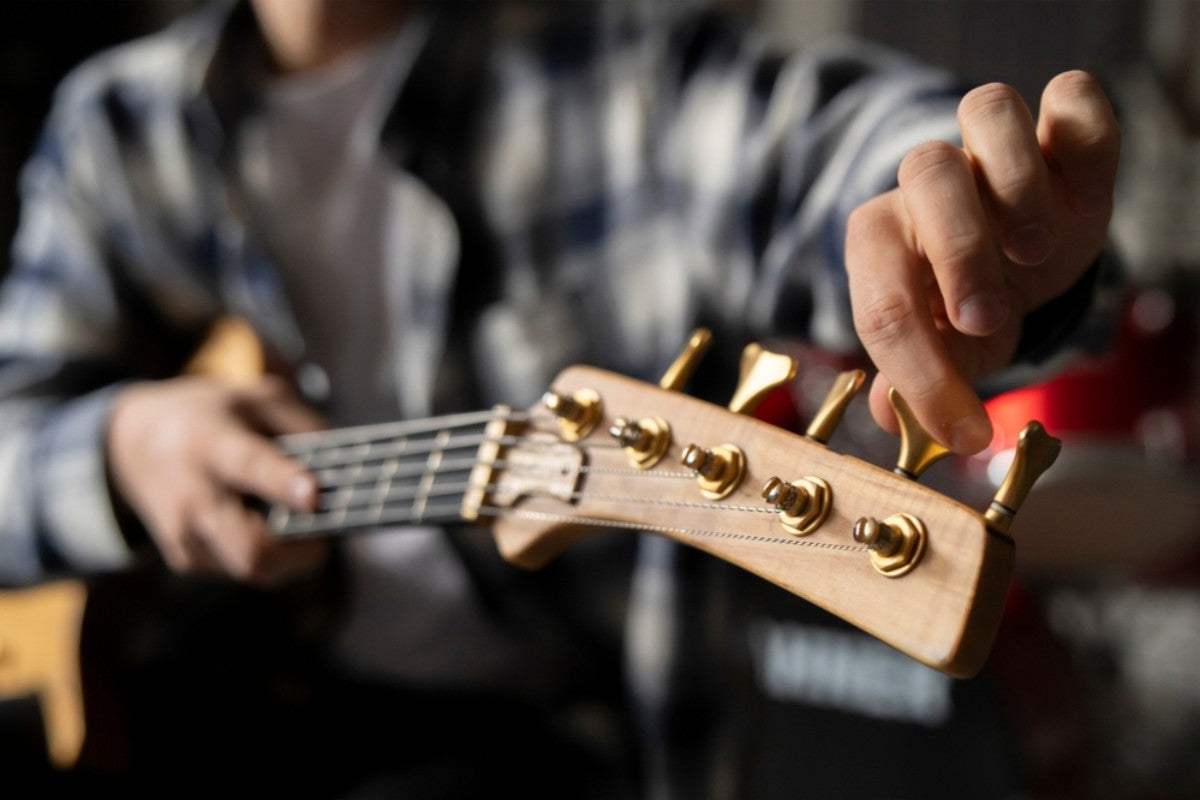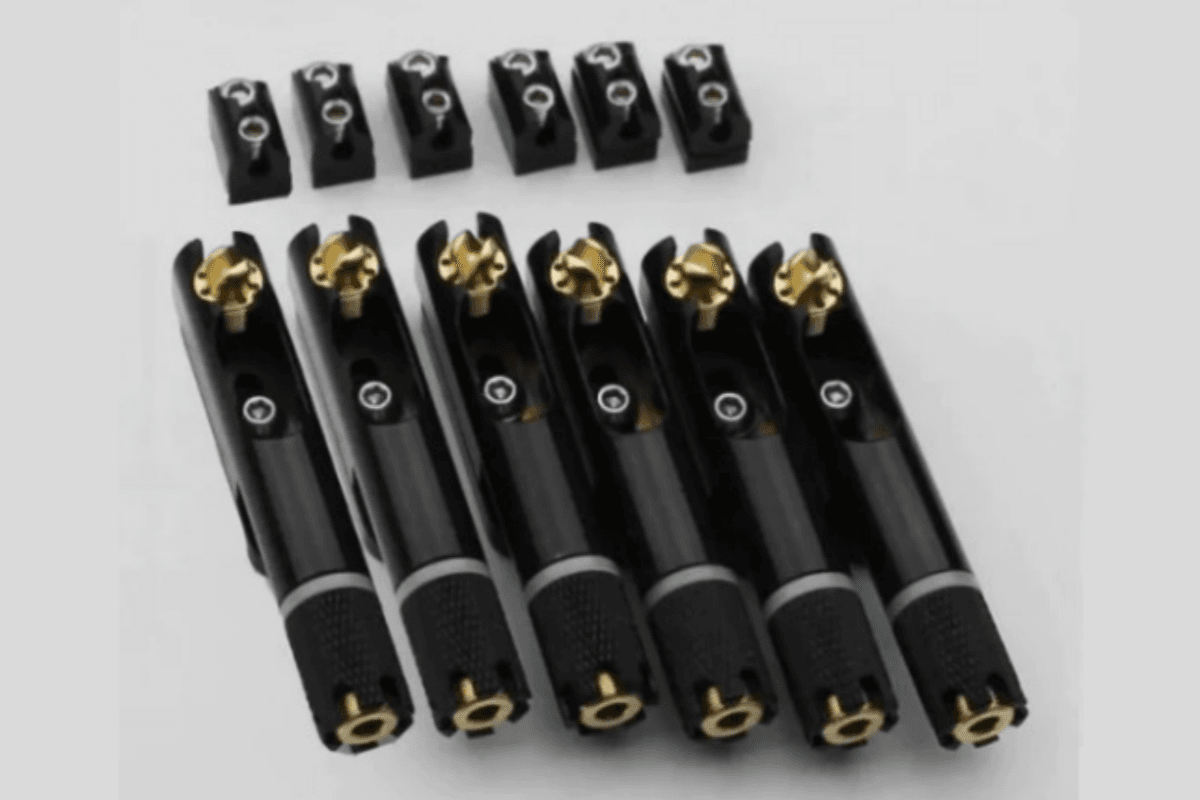Bass players of the world, unite! This is a call to all the bassists who work relentlessly to bring the groove and the low end to life. Yes, bass players are the unsung heroes of the most funky, memorable riffs in history.
Moreover, besides the burden of being the cornerstone of the groove, bass players must carry around an instrument that’s bigger and heavier than that of their bandmates to do their thing.
Well, headless basses could be the answer you were looking for.
We’re going to dive deep into the materials, designs, and options of headless bass bridges the market can offer you. After reading this article, you’ll be able to confidently buy the bridge you need for the headless bass you dream of.
Headless Bass Bridges
Headless basses, as you’ll see further down the article, make outstanding touring instruments in terms of comfort, playability, sound, and portability. They can literally change the way you move around, making your life on the road easier.
So, when it comes to choosing your next bass or building one for yourself, what are the qualities you should look for in a headless bass bridge?
Headless Bass Bridges Fulfill a Double Task
To begin with, these bridges need to work as a regular bridge would; help you adjust intonation and give the bass a specific tone. But that’s not all, they also need to work as your tuning spot.
It’s as if you were looking for a bridge and a set of tuners in the same purchase. It’s important to bear this in mind because we all know that an out-of-tune bass in any musical genre, stage, or recording studio in the world is a golden opportunity wasted.
We’ll talk about the different designs that address this double task a little further down, so read on.
Let’s Talk Materials
The materials used to build the headless bass bridge influence durability and tone.
Durability
First, durability-wise, bass bridges need to employ high-quality metal in every piece. For example, if you’re offered a bass bridge with any plastic or non-metal part, you should know that it might fail from the sweat, wear, and tear of playing the instrument.
If it’s within your budget, always opt for steel or any other high-quality, heavy-duty material when buying your headless bass bridge.
Tone
The second part of choosing a headless bass bridge is tone. Yes, the material your bridge is made of will alter the sound of your instrument.
For example, those who look for a warm, mild, mid-infused sound might want to try something with brass. On the other hand, if you want more clarity and punch, you can always opt for stainless steel.
Let’s Talk Designs
Headless guitar bridges offer many options because there are tremolo units involved. When we talk about bridges for headless basses, the offer is more limited.
Tuner Location
The main difference in the design department is where the tuners are located. Some players love to put the palm of their hands or the pinky over the bridge when they play.
If that’s you, then you should stay away from bridges featuring tuners on top favoring the bridges that allow tuning done on the bottom of the instrument. To begin with, you might take your own instrument out of tune by turning the micro-tuner with your hand.
Secondly, the aforementioned sweat, wear, and tear will break the mechanism faster.
String Spacing
Your preference in terms of string spacing is as personal as your preference in string gauge.
There are headless bass bridges that allow you to fine-tune the string spacing of your bass and there are others that come with a definite string spacing set from the factory.
In this sense, if you’re going for a set string spacing headless bass bridge, you should have something close to 20mm. This is because getting used to larger spaces is easier than trying to cram your fingers into a tiny room.

Fanned Headless Bass Bridges
Fanned frets are a new trend that’s taken over the market at speed. Well, I know what you’re thinking, there’ll be no fanned frets ’62 Fender P-Bass in Sunburst any time soon. That said, headless instruments are the best experimentation ground for innovation because they look futuristic already.
How can a multi-scale headless bass help you? Well, the first thing to say is that adapting each string to the exact scale you like can help you love your instrument even more.
Secondly, the fanned frets also affect tone. The way strings sound with the different tension can help you pull your tone from a muddy swamp by increasing tension on the thicker strings. That said, the bottom strings will be just as comfortable to play with just a little less tension.
The fanned frets basses require a specific type of bridge. These bridges don’t usually work as a unit but as a sum of individual one-string bridges. You can just set them up at the exact scale you need. If one of them goes wrong, just replace that singular piece and move on.
Is A Headless Bass the Ultimate Touring Instrument?
Touring requires moving around, we all know that. Well, moving around requires gear storage and transportation. We know that too. Furthermore, bass players know that better than most other musicians because the 35” of a regular bass scale plus the headstock occupies a lot of space.
But that’s not all because not every bass player in the world has the privilege of playing on large stages, stadiums, arenas, and big venues. On the contrary, most of us arrive at the gig half asleep wondering how we’re going to fit the entire band on that tiny stage.
Well, moving around on stage avoiding hitting your bandmates with a Fender Jazz Bass, for example, requires much more room than moving around with a Steinberger or a headless Ibanez EHB Series bass.
Finally, it’s possible that, depending on the airline, you can fit it in your overhead compartment on your way to that international small pub tour you’re embarking on.
Let’s Talk Double-Ball Strings
I talked about the pros of a headless bass above, but let’s talk about some of the negative aspects and myths surrounding these futuristic instruments. The first and most prominent one is that you need to buy double-ball strings for every model and that string changes are a time-consuming, difficult mission.
Well, most brands have moved forward since the days of double-ball strings. Also, as you might know, bass strings die with time but can last on your instrument, virtually, for as long as you want them to. So, if it’s a hassle, it’s one you won’t face very often.
Conclusion
Headless bass bridges come in several shapes and sizes and all the differences have an impact on tone, durability, comfort, and playability.
We went through those differences in design and materials and you’re ready to pick the headless bass bridge that will better suit your style and sound. We also stopped by to talk about why headless basses can be the answer to all your needs on the road.
Now that you know how to make the most out of your decapitated groove machine, it’s time to go and play it to make people dance, sing, and feel the music.
Happy (headless and groovy) playing!
If you like this article, please share it!
Be sure to join our FB Group Guyker Guitar Parts VIP Group to share your ideas! You can also have connections with like-minded guitar players, Guyker updates as well as discounts information from our FB Group.





